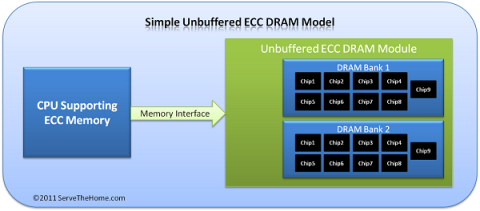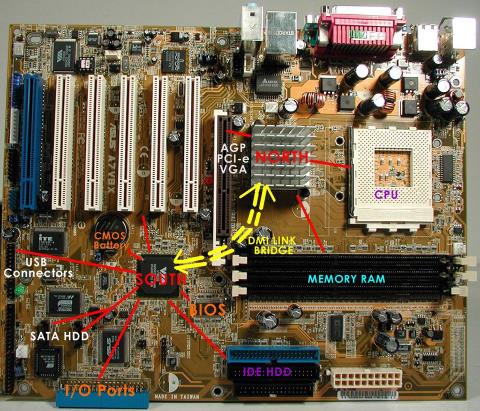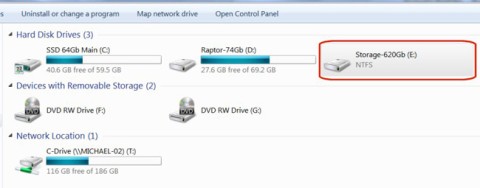What is 3uTools? How to install and use 3uTools in detail

3uTools supports users to manage utility applications more than the traditional way. Easy-to-use interface, will bring interesting experiences to you.
If you are wondering which component of the motherboard needs the most attention, there are certainly many, but one of them called VRM will be the one we need to pay attention to because VRM focuses on helping for stable power of CPU and GPU. So what is VRM and how does it work? Let's learn about this article with WebTech360 .
The VRM (Voltage Regulator Module) circuit is the voltage regulator in the motherboard. With the presence of VRM, the CPU and GPU will be provided with clean power to operate stably.
The VRM circuit is capable of converting DC power to a lower value. For example, the VRM can convert +12VDC or +5VDC power to +1.3VDC or 1.1VDC so that CPU and RAM can work properly. This voltage level is also kept at different limit, they are also known as “DC to DC converter”.
The conversion of voltages into different levels is not a new technology. However, it plays a very important role to ensure the normal operation of electrical and electronic systems.
When the VRM circuit is poor, it will affect the performance of the processor when it loads tasks. More seriously, the computer system can be turned off suddenly, especially when OC. Therefore, users need to pay more attention to this part to help the computer work well.
A modern computer power supply (PSU) typically supplies 12V to the motherboard. However, CPUs and GPUs cannot withstand that voltage. At that time, the VRM will work its magic when adjusting the source to about 1.3V, 1.1V or lower so that the GPU/CPU works in the best state.
The VRM circuit must work correctly to avoid unfortunate incidents, especially those affecting the CPU. This explains why its structure is much more complicated than that of conventional transformers.
Basically, a VRM circuit is a buck converter - a type of device that can drop exactly the desired voltage level. The structure of the circuit consists of 3 main parts which are:
- MOSFET: Metal-Oxide Semiconductor Field-Effect Transistor.
- Inductor
- Capacitor
In addition, they are also integrated with control ICs (also known as PWM controllers). There are two common types of VRM circuits: single-phase and multi-phase. In particular, most computers today are equipped with multiphase circuits with the following schematic diagram:
The phases of the VRM circuit will take turns supplying power to the CPU for short and staggered intervals. Therefore, at a time, only 1 phase is active, but the total power generated for the supply remains stable. This is an important factor for the computer to work well and promote the performance of the CPU/GPU.
Using a multiphase VRM circuitry also brings a pretty big benefit in terms of heat dissipation. The transmission of power over a larger area reduces local heat generation. This reduces pressure on system components, improving power and operating costs.
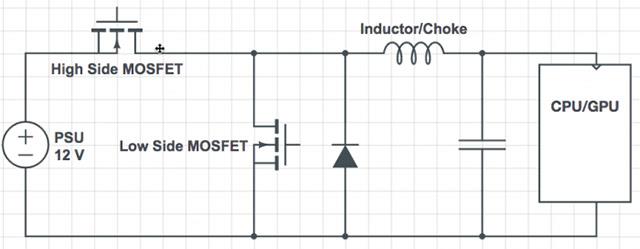
VRM Single Phase
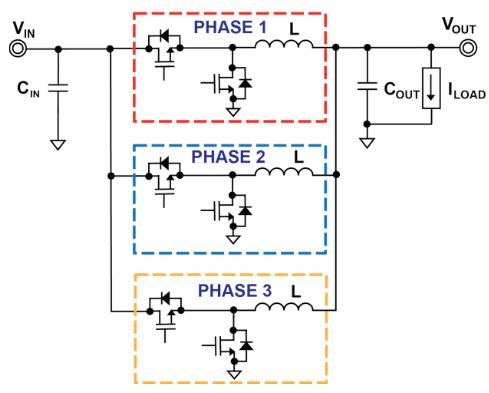
Multi-Phase VRM
Multiphase VRM circuits are sold with the symbol “ 6+2” or “8+3” . The number before the plus sign is the number of phases dedicated to providing power to the CPU. The other number indicates the number of phases to supply voltage to other components of the motherboard such as RAM.
In case the first number is greater than 8, namely “12 + 1” or “18 + 1” , the actual number of phases is not so large. The manufacturer will use a voltage doubler (doubler) with the operating method is to split the power between the two lanes of MOSFET, capacitor and inductor available in each phase.
Thanks to the doublers, the manufacturer will take advantage of the benefits of the current phase without having to install additional physical phases, thus saving a lot of costs. However, mirrored phases will not be quite as efficient as real ones. The frequency of the supply current will be halved and there will be a certain delay. Moreover, at a time, only 1 of 2 phases can be turned on. Therefore, the way to create a VRM circuit with multiple phases using a doubler is just a way of marketing sales of the manufacturers, not bringing too much effect in reality.
Example: A VRM with 6 phases mirrored (to 12 phases) will typically perform less efficiently than a real 7 or 8 phase VRM.
With a basic VRM, it was possible to ensure the power source for the mid-range CPU to operate in a state. But when you need to overclock or perform performance-intensive tasks, then the quality of the VRM circuit will become more important.
The reason is because with 2 power supplies of the same power level, the one with VRM can give you a higher maximum power level of each line. As a result, power-intensive tasks will be quickly responded to by the VRM circuit. Users also do not have to invest in a larger power supply to meet the operation of the machine.
Hope this article helped you visualize the importance of VRM as well as answer questions related to this important component. Wish you will choose a quality motherboard as well as know which is a good motherboard to build a quality computer set at the best price!
3uTools supports users to manage utility applications more than the traditional way. Easy-to-use interface, will bring interesting experiences to you.
Rendering is the process of creating an image from a model into a movie scene or image using computer software.
The CPU is the data processing center, or simply understood, it is the brain that controls most of the rest of the components in a computer.
The GPU is the processor that handles graphics-related tasks for the CPU's central processor. Features on GPUs go far beyond basic graphics drivers like Intel's GPU
Flyer is a form of advertising, a marketing product that has existed for a long time, also known as leaflets, product marketing brochures.
ECC RAM is a type of RAM that has the ability to control the flow of data accessed in it to help automatically correct errors. ECC RAM has very high stability which helps you to reduce risk.
Ray Tracing is a technique that helps a computer create an image by tracing the path of light through pixels on the same image plane.
Chipset is a collection of chips, chipset refers to the chip on the mainboard or on the expansion card. On PC, commonly known as northbridge and southbridge.
Hyper threading is a hyper-threading technology and is known as Intel HT technology by globally famous technology manufacturer Intel.
On the quality screen, they integrate a technology called V-Sync, FreeSync. Let WebTech360 explain to you about V-Sync, what is FreeSync?
Anti-aliasing is the main adjustment mode to help objects and people become softer and not angular, the game experience will also be better.
Animation is an age-old method in which people make motions of images based on still images.
Footage is unedited raw footage and footage. You can understand that footage is all the components that make up a video, and footage is very diverse.
Storyboard is a storyboard, consisting of a series of illustrations and accompanied by notes about what is going on, carrying the content of the story.
In addition to regular exercise and not smoking, diet is one of the best ways to protect your heart. Here are the best diets for heart health.
Diet is important to our health. Yet most of our meals are lacking in these six important nutrients.
At first glance, AirPods look just like any other true wireless earbuds. But that all changed when a few little-known features were discovered.
In this article, we will guide you how to regain access to your hard drive when it fails. Let's follow along!
Dental floss is a common tool for cleaning teeth, however, not everyone knows how to use it properly. Below are instructions on how to use dental floss to clean teeth effectively.
Building muscle takes time and the right training, but its something anyone can do. Heres how to build muscle, according to experts.
The third trimester is often the most difficult time to sleep during pregnancy. Here are some ways to treat insomnia in the third trimester.
There are many ways to lose weight without changing anything in your diet. Here are some scientifically proven automatic weight loss or calorie-burning methods that anyone can use.
Apple has introduced iOS 26 – a major update with a brand new frosted glass design, smarter experiences, and improvements to familiar apps.
Yoga can provide many health benefits, including better sleep. Because yoga can be relaxing and restorative, its a great way to beat insomnia after a busy day.
The flower of the other shore is a unique flower, carrying many unique meanings. So what is the flower of the other shore, is the flower of the other shore real, what is the meaning and legend of the flower of the other shore?
Craving for snacks but afraid of gaining weight? Dont worry, lets explore together many types of weight loss snacks that are high in fiber, low in calories without making you try to starve yourself.
Prioritizing a consistent sleep schedule and evening routine can help improve the quality of your sleep. Heres what you need to know to stop tossing and turning at night.
Adding a printer to Windows 10 is simple, although the process for wired devices will be different than for wireless devices.
You want to have a beautiful, shiny, healthy nail quickly. The simple tips for beautiful nails below will be useful for you.




